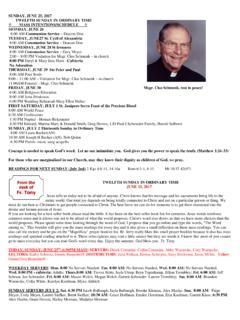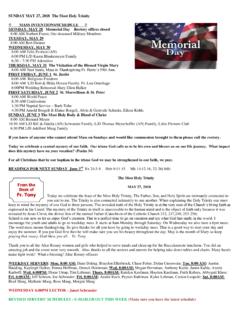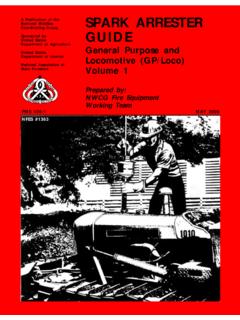Transcription of DLCO: Diffusion lung capacity for Carbon Monoxide
1 DLCO: Diffusion lung capacity for Carbon Monoxide What is DLCO? The DLCO measures the ability of the lungs to transfer gas from inhaled air to the red blood cells in pulmonary capillaries Diffusing capacity is intended to provide an estimate of the rate at which test molecules move by Diffusion from alveolar gas to pulmonary capillary blood flow. Lung Function: Physiology, Measurement and Application in Medicine 2006 by John E. Cotes What's in the name? Diffusing capacity is an earlier name for transfer factor, still used in many centers. It is inappropriate for two reasons It is usually obtained at rest when the index is submaximal so it is not a capacity measurement Several processes contribute to the rate constant, not only Diffusion Lung Function: Physiology, Measurement and Application in Medicine 2006 by John E. Cotes Why CO and not O2/Nitric Oxide? Oxyhemoglobin dissociates readily so there is a material back tension of oxygen in the plasma CO is not normally present in body thereby causing practically no back tension.
2 Nitric oxide is an excellent alternative but it is of recent origin and data regarding normal and predicted values is lacking Ruppel's Manual of Pulmonary Function Testing Paperback 2012. by Mottram What's so specially about CO? Has a high Haldane constant Binds with Hb 200-300 time more avidly than Oxygen Reverse reaction being extremely slow. Practically no back pressure/tension Ruppel's Manual of Pulmonary Function Testing Paperback 2012. by Mottram Terminologies DLCO: Diffusing capacity of the lungs for Carbon Monoxide VA: The alveolar volume (VA) can be considered the number of contributing alveolar units. KCO: The Carbon Monoxide transfer coefficient is often written as DLCO/VA. kCO: The permeability factor is the rate constant for alveolar- capillary CO transfer. Ruppel's Manual of Pulmonary Function Testing Paperback 2012. by Mottram Physiology Reflect properties of the alveolar-capillary membrane, The process of Carbon Monoxide (CO) uptake can be simplified into two components: membrane conductance (DM) and reactive conductance, the chemical reaction between CO and hemoglobin.
3 1/DLCO = 1/DM + 1/RVc Ruppel's Manual of Pulmonary Function Testing Paperback 2012. by Mottram Procedure Steps 1. Subject exhales to RV. 2. Inhales a mixture of predetermined tracer gas and CO. 3. CO mixes with RV. 4. CO reaches alveolar membrane and diffuses across 5. CO crosses RBC membrane 6. Binds with Hemoglobin 7. Subject exhales to RV. 8. Exhaled sample is analyzed Preparation No cigarette smoking on the day of the test. No use of inhaled bronchodilators on the day of the test No supplemental oxygen for at least 15 minutes prior to and during the test Use of supplemental oxygen can decrease DLCO by %/mmHg change DLCO Maneuver 3 to 4 normal breaths Followed by full inspiration, full expiration and than full inspiration and hold for 10 sec 2, followed by forceful exhalation Gas: CO, 0 to 14% helium, 21% O2, rest N2. Summary of the procedure Inspiratory maneuver Sample collection volume If VC<2L, reduce to Dead space washout( L).
4 If VC<2L, reduce to breath hold Quality of the test The inspiratory volume should be greater than 85 percent of the largest VC. The inspiratory time should ideally be less than two seconds; greater than four seconds is unsatisfactory The sample collection time should be less than three seconds. The first to 1 L is discarded as dead space gas and then a sample gas volume of to 1 L is collected for analysis. Eur Respir J 2005; 26: 720 735. Common Fallacies The gases, how they are analyzed? Carbon Monoxide is analyzed by infrared absorption The detector has a useful life of 10 years The linearity of the analyzer is more important than the accuracy because the principal objective is to obtain the ratio of the expired to the inspired Carbon Monoxide concentration Infrared analyzers are sensitive to Carbon dioxide and to water vapors Lung Function: Physiology, Measurement and Application in Medicine 2006 by John E.
5 Cotes To enhance the specificity of the analysis, first the CO2 and then the water vapor should be absorbed CO2 by soda lime and water vapors by anhydrous calcium chloride or copper sulphate. The treatment reduces the volume of the sample and this, in turn, increases the concentrations of helium and Carbon Monoxide . Lung Function: Physiology, Measurement and Application in Medicine 2006 by John E. Cotes Theory and calculations During breath holding, CO leaves alveolar gas at an exponential rate. VA is the alveolar volume which is calculated by knowing the fractional concentration of the tracer gas in the inhaled and exhaled gas F1V1 = F2V2. VA = VI x (FI tracer/FA tracer). Lung Function: Physiology, Measurement and Application in Medicine 2006 by John E. Cotes Fick's Law ( 1 2). Vol gas transferred .. A is Area . D is Diffusion constant D .. P is partial pressure between two sides T is thickness of the membrane Lung Function: Physiology, Measurement and Application in Medicine 2006 by John E.
6 Cotes Resistance Dm = membrane conductance Qc = effective capillary blood volume, in mL. Hb = Hemoglobin concentration as a fraction of normal = constant for the rate of CO uptake by the erythrocytes per mL. normal blood Transfer factor for Carbon Monoxide M. Horstman, F. Mertens, H. Stam Alveolar Volume VA = Alveolar volume FI,He = He fraction in the inspired gas FA,He = Alveolar He fraction at time t VI = inspired volume in liters BTPS. VD = total dead space in liters BTPS. Transfer factor for Carbon Monoxide M. Horstman, F. Mertens, H. Stam Relation between Helium and CO. FI,CO = CO fraction in the inspired gas FI,He = He fraction in the inspired gas FA,He = Alveolar He fraction (after t sec). FA,CO0 = Alveolar CO fraction at zero time Transfer factor for Carbon Monoxide M. Horstman, F. Mertens, H. Stam Exponential decay constant (kCO). 0 = Start time in s t = End time in s FA,COt = FA,CO at time t FA,CO0 = FA,CO at time 0.
7 Transfer factor for Carbon Monoxide M. Horstman, F. Mertens, H. Stam Exponential decay constant (kCO). TLCO is in mol/s/kPa PB= barometric pressure PH2O,sat = the saturated water vapor pressure VA,max = the alveolar volume at TLC level in liters KSTPD = the conversion factor for the conversion from liters BTPS to STPD. Transfer factor for Carbon Monoxide M. Horstman, F. Mertens, H. Stam Transfer factor for Carbon Monoxide M. Horstman, F. Mertens, H. Stam Measurement of diffusing capacity Methods Technique Single breath-holding method Patient conditions Single expiration method Inspiratory maneuver Rebreathing method Breath-hold Steady state method Expiratory maneuver Steady state methods Susceptible to uneven lung ventilation especially when ventilation is low on account of the measurement being made at rest. The method is more reliable during exercise. It is used at rest if the subject cannot cooperate in the measurement Lung Function: Physiology, Measurement and Application in Medicine 2006 by John E.
8 Cotes Breath holding methods Proposed by Bohr and developed by Marie Krogh Merit of minimizing regional inequality as it is measured at total lung capacity Simple to perform by all but the most disabled subjects The method is suitable for respiratory surveys Reference values are available It is used in a majority of lung Function laboratories. The method is recommended internationally Lung Function: Physiology, Measurement and Application in Medicine 2006 by John E. Cotes Single breath Steady state Easy for the lab Requires no respiratory Well standardized maneuvers Less affected by Non uniformity of ventilation Difficult to perform by dyspneic Technically difficult patients, during exercise Gives lower values than single breath method Lung Function: Physiology, Measurement and Application in Medicine 2006 by John E. Cotes Interpretation Patient's result is interpreted by comparing it with the predicted value or the lower limit of normal Severe respiratory impairment is defined as a DLCO below 45 percent of the predicted value What affects DLCO.
9 Thickening of the alveolar-capillary membrane Loss of alveolar membrane surface area Reduction in volume of RBC in pulmonary capillaries (approx. 150 ml). Carboxyhemoglobin levels Altitude Lung volume Fishman's Pulmonary Diseases And Disorders . 2015 by Michael A. Grippi Anemia The adjusted value estimates the DLCO if the patient were to be having normal hemoglobin DLCO falls about 9 percent during menstruation DLCO predicted for Hb = DCLO predicted x factor where factor = ( x Hb)/( + Hb). In children under 15 yrs of age and females is: where factor is = ( x Hb)/( + Hb). Carboxyhemoglobin and cigarette smoking The carboxyhemoglobin level may be elevated in the blood if the patient was smoking just prior to the DLCO measurement. An increase of 1 percent in COHb results in a proportionate 1 percent decrease in the measured DLCO. Smoking cessation results in a mean DLCO increase of 2 to 4 mL/min per mmHg within a few days High altitude If the laboratory is located at high altitude, the ambient, alveolar, and arterial oxygen concentrations are lower than at sea level.
10 The lower arterial oxygen concentration results in less competition for CO binding to hemoglobin, increased CO uptake. And higher measured DLCO compared to a test done at sea level. Volume correction DLCO/VA (KCO) reflects alveolar CO uptake efficiency at a given volume In the past, the term DLCO/VA (also known as KCO) was misinterpreted as a correction factor for low lung volume, leading to potential misinterpretation of DLCO results Nonetheless, the average VA of the tests used to generate the reported DLCO should be reported. Relationship between DLCO & KCO (DLCO/VA). Incomplete lung expansion In patients who have neuromuscular disorders, kyphoscoliosis, or inadequate inspiration due to poor test performance, the KCO (DLCO/VA) is elevated. Pneumonectomy For patients who have undergone pneumonectomy, but do not have lung disease, the VA is decreased due to discrete loss of alveolar units.





